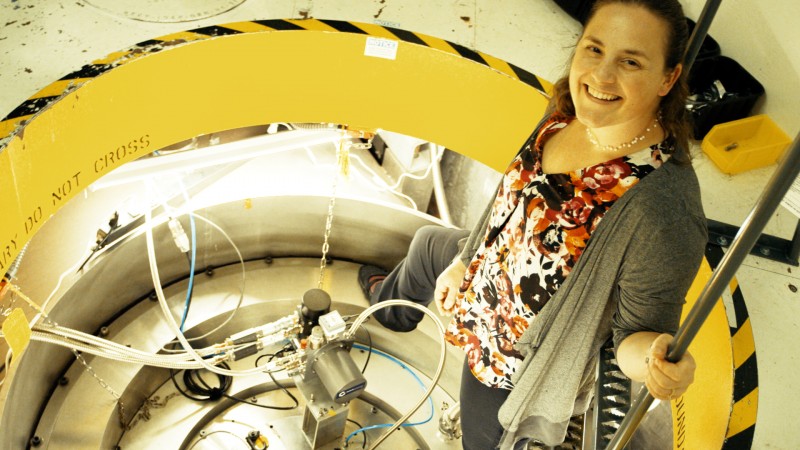In 1675, Isaac Newton famously wrote, “If I have seen further, it is by standing on the shoulders of giants." History records that even Newton had help climbing onto those shoulders, which shows the need for forward-thinking scientists who influence tomorrow’s researchers by doing some of the heavy lifting today.
Few have done as much lifting in their early careers, from a combined scientific and athletic perspective, as Katharine “Kate” Page, a neutron scattering scientist at the Department of Energy’s Oak Ridge National Laboratory and three-time collegiate national champion in Olympic-style weightlifting. Page says she often sees parallels between her work as a scientist and her past participation in sports, which also included competing in Division I varsity track for the University of Maine, in Orono, where she holds the record in the women’s discus event.
“I believe teamwork is vital in any field, because collaborating as a team enriches our work and ensures we have the strongest group looking at each and every challenge from different perspectives,” Page said.
A materials girl
Although her undergraduate degree was in chemical engineering and she interned at the NASA Glenn Research Center, it was Page’s work during a college internship at Los Alamos’ Lujan Neutron Scattering Center that first interested her in the rapidly growing field of materials science.
After earning her doctorate in materials from the University of California—Santa Barbara, she completed a director’s postdoctoral fellowship at Los Alamos National Laboratory, studying materials at neutron and synchrotron radiation facilities around the world. She became an LANL staff scientist in 2011.
Three years later, Page moved to East Tennessee to work at ORNL as a neutron instrument scientist. “I was very inspired by the idea of working at ORNL, the birthplace of neutron diffraction,” she said. “My career path was ultimately made possible by Ernest Wollan, who in 1944 made the first neutron scattering experiment here at the Graphite Reactor, which is now a museum near my office. I’m energized by the opportunity to advance scientific research while adding to ORNL’s rich history of developing neutron scattering instrumentation and capabilities.”
In addition to the scientific history at ORNL, Page also appreciates the technology at the laboratory that supports her work, and its setting in the foothills of the Great Smoky Mountains.
“I love the people here, the natural woodland setting, and the incredible scientific capabilities of not just one, but two, world-class neutron sources,” said Page. “The technology enables me to study new materials and understand how they can broadly impact our nation’s energy storage and catalysis fields, while the scenery reminds me that our work here also has larger implications for our environment and the world as a whole.”
Early returns
In 2015, Page was one of four researchers at ORNL, and one of only 44 researchers nationwide, selected by DOE’s Office of Science to receive funding under the department’s Early Career Research Program. The five-year grant, which helps support researchers during the early stage of their careers, was awarded to her as the principle investigator on an ORNL project titled “Exploiting Small Signatures: Quantifying Nanoscale Structure and Behavior.” The work involves applying neutron scattering methods to uncover the links in nanostructure between surface chemistry, particle morphology, and internal crystalline structures in different functional material families.
More recently, in July 2018, Page received an Exceptional Service award from the Neutron Scattering Society of America for her work as the organization’s secretary. The society president, Despina Louca, also mentioned Page’s involvement in organizing schools and workshops for current and future neutron scattering users. “When the award was presented it was mentioned that it is usually given to someone further along in their career than I am. So going forward I guess I’d better work hard to not let them down,” joked Page.
IDREAM team
Since 2016, Page has represented ORNL as part of the Interfacial Dynamics in Radioactive Environments And Materials (IDREAM) team, part of the Basic Energy Sciences Program’s Energy Frontier Research Center, led by Pacific Northwest National Laboratory. IDREAM focuses on providing a scientific basis to accelerate processing DOE’s high-level radioactive wastes by better understanding chemical and physical phenomena in complex environments. “We want to facilitate innovations in radioactive waste characterization and transformation to determine what can occur as radioactive wastes continue aging over the many decades it will take to complete complicated rad waste cleanup tasks,” said Page.
Her projects have also benefitted the industrial sector. In 2017, Page was part of a team of scientists from ORNL and Colorado State University that developed a gas flow cell capable of studying the atomic structure of catalysts in real time. Traditional research approaches had only examined catalysts and other products before or after a reaction had taken place. However, using the new gas flow cell for neutron diffraction and total scattering experiments, researchers can now mimic real-world conditions with industrial relevance—such as for catalytic converters in vehicles—to supply insights into the variable relationships between a catalyst and its performance and reaction products.
“By integrating the cell into a new sample environment, researchers can now combine neutron diffraction and isotope analysis to view catalytic behavior under realistic operating conditions,” said Page. “The device was quickly adopted by other neutron scientists and the user community, which was really exciting for our team.” This gas flow cell technology is expected to pay dividends during Page’s co-investigator role in the recently renewed Center for Understanding and Control of Acid Gas-induced Evolution of Materials for Energy, part of DOE’s Energy Frontier Research Center program.
An advocate for science
Page’s enthusiasm for her work is apparent when she talks about helping kids discover and develop a love of science, and when she advises older students on their career choices, which is something that Page has made part of her life’s mission. Through various student outreach programs, dozens of invited talks, and a wide range of workshops, she advises students to explore different areas of interest, and encourages young scientists to try new career options and to always ask questions and learn from others along the way.
“My first taste of discovering the unknown came when I was in college doing undergrad research. The idea that there were questions that nobody knew the answers to, and research that I could possibly contribute to, really inspired me,” said Page, who grew up in a rural community in central Maine. “I sometimes wish I’d discovered my own scientific curiosity at an earlier age, which I think is why I feel so strongly today about discussing science with kids and younger scientists.”
Page often credits Thomas Proffen, now the director of ORNL’s High-Performance Computing and Data Analytics Initiative, with helping channel her interests into materials research when they both worked at LANL. “Thomas is someone who enjoys serving as both a mentor and a science advocate,” Page said. “Someday I want my own legacy to include having helped solve tough problems and paved the way for others by working to develop important research capabilities and facilities to make discoveries that educate, inspire and assist future generations of scientists.”
True to her word about building things for future researchers, Page has agreed to serve as ORNL’s internal lead for the concept development of the DISCOVER beamline project, a total scattering diffractometer that the science community hopes to build at the Spallation Neutron Source, a DOE Office of Science User Facility, in the next few years. Page added, “it’s a great privilege to serve the nation and international science community by working toward delivering exciting instrument capabilities that will enable new discoveries in the years and decades to come.”
ORNL is managed by UT-Battelle for DOE’s Office of Science. The Office of Science is the single largest supporter of basic research in the physical sciences in the United States, and is working to address some of the most pressing challenges of our time. For more information, please visit http://science.energy.gov/.—by Paul Boisvert




